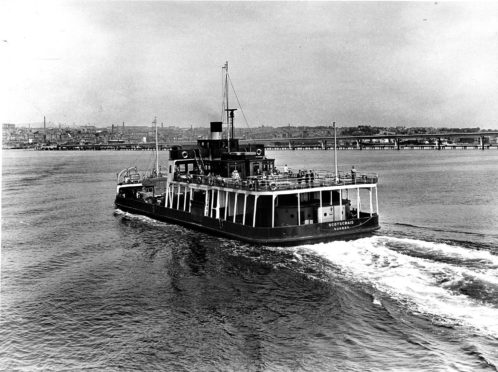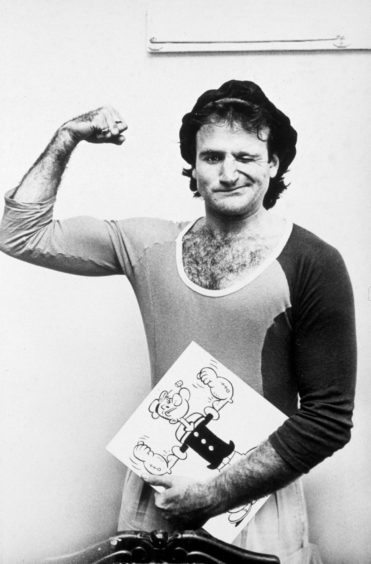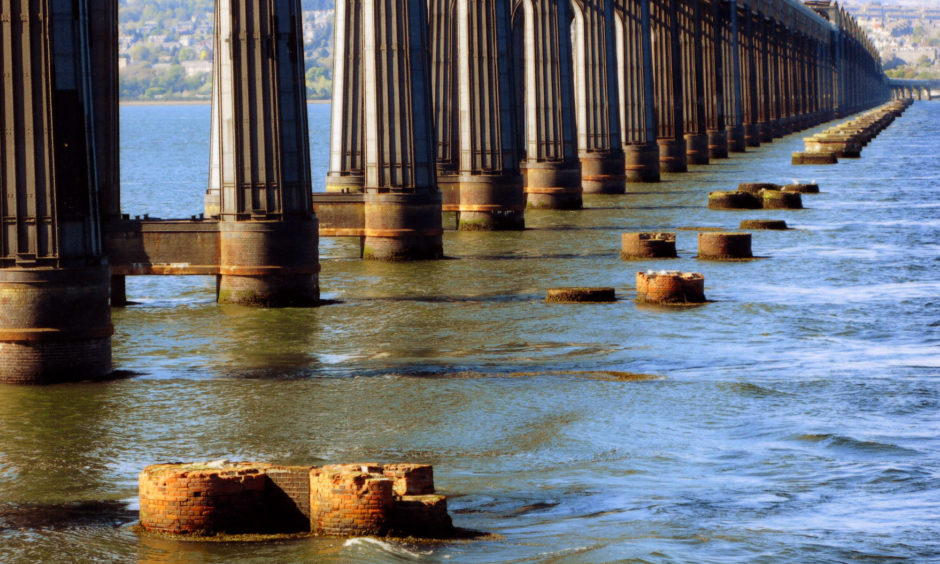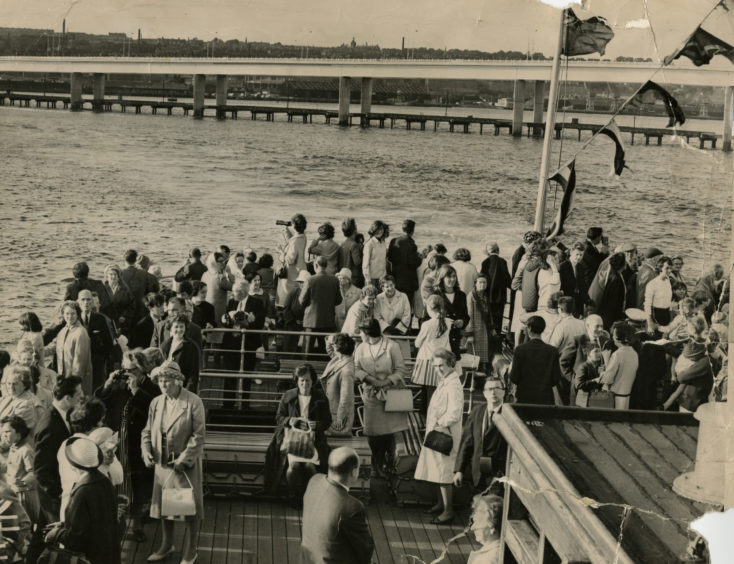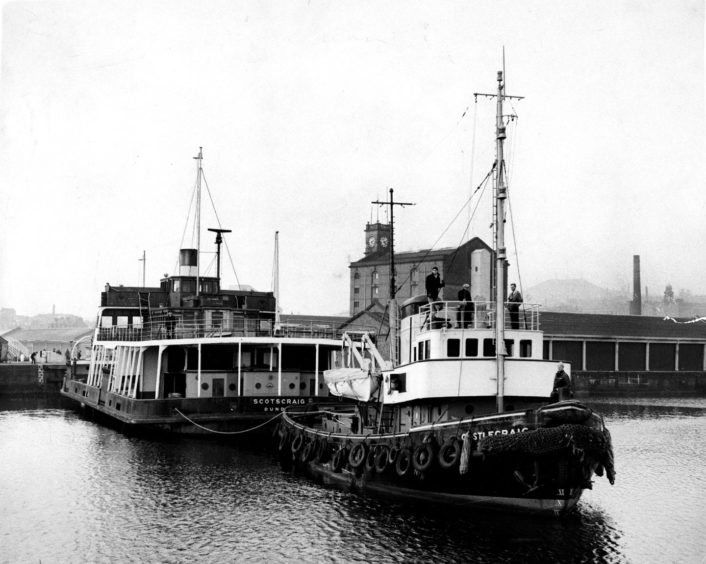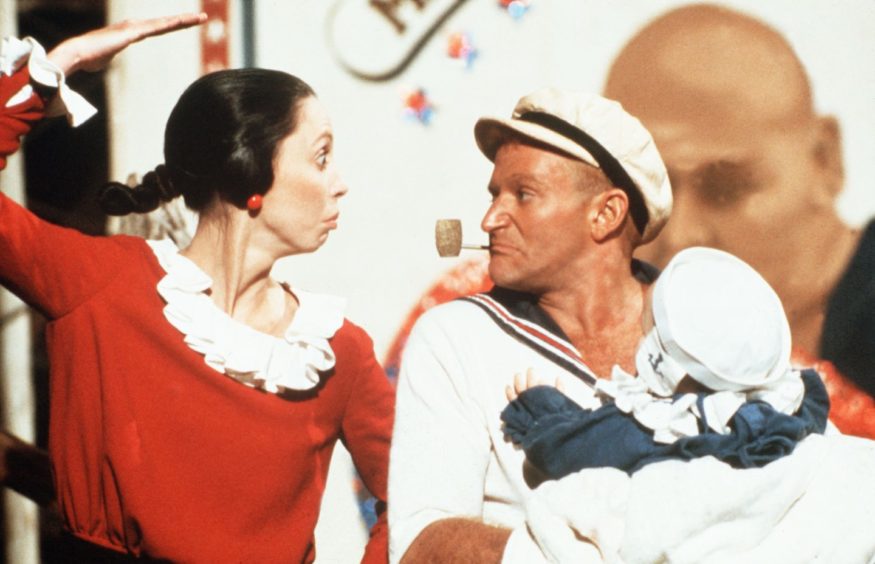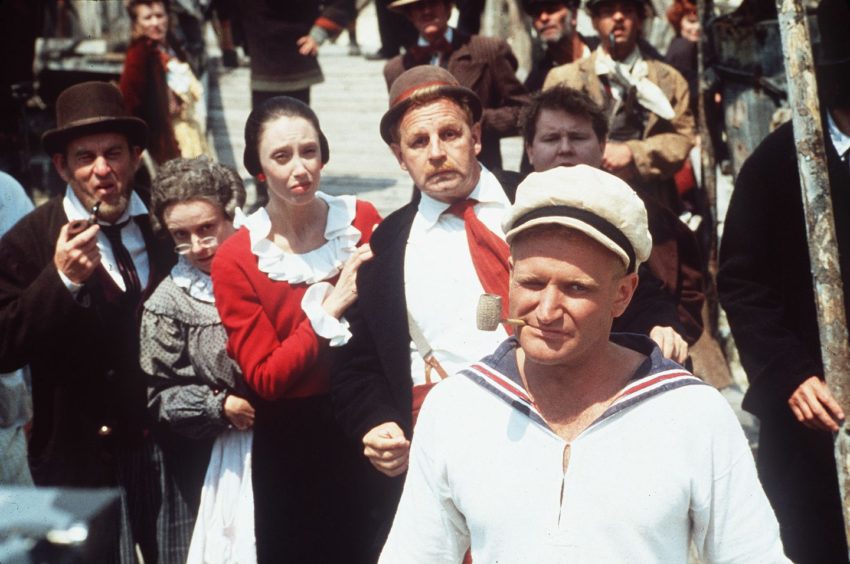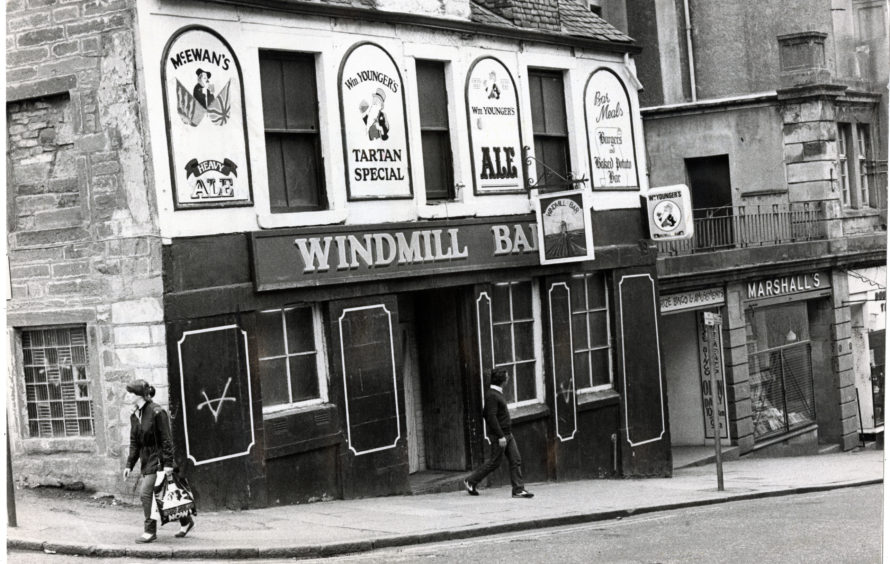She made history as the last ferry to make the Tay crossing in 1966.
The MV Scotscraig then went on to become a Hollywood movie star 40 years ago.
The ferry, which was the fourth of its kind to be built in Dundee in 1951, featured as the Popeye Barge in the live action version starring the late, great, Robin Williams.
She was the 14th ship to operate the service since sail and oar gave way to steam in 1821 which only stopped with the opening of the Tay Road Bridge in 1966.
‘Her very special ship’
Dundonians used the Fifies as a way to escape the smoke of the city and take a trip to the countryside in Fife.
The Scotscraig was built for the Dundee Harbour Trust for the Dundee to Newport ferry crossing.
The Scotscraig was the fourth Caledon-built ferry for the River Tay crossing and was launched in May 1951 by Mrs F J D Buist who was the wife of the convenor of the Tay Ferries Committee of the Harbour Trust.
Mrs Buist was presented with a diamond and gold brooch at the launch and said she would always look upon the Scotscraig as her very special ship.
The ship was launched during “Dundee-Made Week”.
Diesel-engined and Voith-Schneider propelled, the Scotscraig was built on the same general lines as the Abercraig with large vehicular capacity and room for 800 passengers.
The Scotscraig and Abercraig, at £171,000, cost more than the total of the previous 12 ferries.
The link between Dundee Harbour Trust and the Caledon Company went back to 1894 when a barge was built.
The first ferryboat was the Newport in 1909, followed by the Sir William High in 1924 and the B L Nairn in 1924.
Since the B L Nairn, traffic had increased enormously, particularly heavy lorries, confronting the Trust with many problems not only in the design of ships, but also the piers and approaches.
Road bridge a ‘distant project’
Alexander Lickley Proctor, chairman of Dundee Harbour Trust, said the Scotscraig would be welcomed not only by passengers and drivers, but by the masters of the ships.
Edgar Brown, chairman of the Caledon Company, said the ideal method of crossing the Tay would be a road bridge.
A passenger bridge over the Tay had first been suggested just before the First World War.
Plans were drawn up for a new bridge using the base of the first rail bridge but this fell through.
Mr Brown said the circumstances were such that a road bridge could only be a distant project and the Fifies “still had a long future”.
The steamboat ferry Dundee was scrapped just a year later in 1952 and the Sir William High was sold to a Norwegian buyer.
Numerous campaigns were also launched over the years to have a bridge built before finally a Tay Road Bridge Committee was set up by the council.
England had just won the 1966 World Cup when the city of Dundee was about to enter a new era of its history with the opening of the longest road bridge on the continent.
But then there were just three boats left, the B L Nairn, the Abercraig and the Scotscraig.
Last ever Tay ferry crossings
The Fifies were still in daily use, leaving Dundee and Newport on the hour and half past the hour.
The last ferry from Dundee was 10pm whilst the last ferry from Newport was 10.30pm.
The crossing itself took approximately 20 minutes.
The last ever Tay ferry crossings took place in the shadow of the new road bridge.
They were made a special ‘tickets-only’ affair at five shillings.
The band played ‘Bonnie Dundee’
On August 8 in 1966 the flag-decorated Scotscraig, escorted by the lifeboat Robert, picked up a Newport party of 200.
Back at Craig Pier another 500 boarded, and at 6.30pm, the ferry pulled out into the river with the RNVR Band aboard playing ‘Bonnie Dundee’.
Passengers sang ‘The Old Hundredth’ and the Rev Dr H M Bartlett read the lesson.
Rev Robert A Howieson paid tribute to the ferries and crews.
Jets and a helicopter from Leuchars flew overhead.
Scotscraig captain was Sandy Mann and the mate Bert Fallows.
The passengers sung ‘Auld Lang Syne’ and on the final return to Dundee there was dancing on deck.
The ferry boats then returned to Victoria Dock shortly after the bridge opened to await their fate.
The B L Nairn was scrapped after the bridge opened.
Abercraig and Scotscraig were towed to Portsmouth by a German tug in 1968 before being moved to Malta where side-loaders were more suitable for some of the island-to-island routes.
Dundee historian Norman Watson said: “Although long gone, the Tay Ferries were one of the first railway-ferry services in the world.
“They deserve their place in Dundee’s wonderful maritime history.”
Hollywood starring role
In 1980 the Scotscraig moved to Anchor Bay just a couple of miles from Mellieha in Malta after nearly 200 workers spent seven months to construct Sweethaven Village for the production of the live-action musical feature film Popeye.
Principal photography commenced in January 1980 and part of the film was made on the Scotscraig which was billed as the Popeye Barge.
After the production cost rose beyond $20 million, Paramount ordered director John Altman to wrap filming and return to California with what he had.
The film set village was abandoned, so the locals of Mellieha reclaimed it as a Popeye theme park, and it remains there to this day.
But the vessel ingloriously sank in 1981 and was then given another starring role as an underwater wreck off the island’s coast and became a tourist attraction for scuba divers and marine film producers.
It is a haven for many species of fish such as conger, groupers, rays, and octopi.
Popeye star Williams knew all about Dundee after staying in the city several times in the early 1970s during appearances at the Edinburgh Festival before he was famous.
Lorne sausage and tattie scones
Williams was in digs in the Stannergate and became a well-known face at the Hungry Mary’s cafe where he was particularly fond of lorne sausage and tattie scones.
Local comedian Bobby Barty invited the young Williams to the Windmill Bar in the Hilltown where he was performing.
He returned to impress regulars at the pub with his impressions including his Scottish accent which he then used in the classic Mrs Doubtfire.
Dundee man Joe McKay later told how a chance encounter with the aspiring comedian showed his kind nature.
He said: “About 1971, I was regularly driving my lorry to Portobello Docks in Edinburgh.
“I gave a young man a lift from Perth Transport Cafe.
“It was Robin Williams.
“In return for the lift, Robin helped me unload two dozen cases of orange juice.”
Scotscraig’s sister ship the Abercraig was finally broken up in Malta in 1995.
Williams passed away in 2014.
Memories are made of this
The original Fifeshire was built in 1858.
For 70 years she crossed the Tay before spending her last few years in semi-retirement.
The veteran was the first twin paddle steamer to ply between Dundee and Fife.
But she came only fifth on the list of steam ferries.
The first four had only one paddle.
The Union and George IV
The pioneer Union which was built at Perth in 1821, and her slightly larger successor, the George IV, launched from the same yard two years later, were strange vessels.
The Union had two separate hulls joined by wooden beams with the paddle wheel between them.
Each hull had an engine and a rudder.
There were two funnels, one on each hull.
In the case of the George IV, the deck space was divided into three – the certain portion for passengers and the rest for cattle.
The public accused the management of showing “a superabundant partiality for brutes”.
Adventures far from home
However there were two cabins for passengers to use in wet weather.
In good weather they averaged 17 to 23 minutes.
At first the Union made alternate crossings to Newport and Woodhaven.
But this caused so much confusion it was decided to run the service to Newport only.
One or two of the Fifies have figured in adventurous episodes far from home in contrast with their duties on the Tay.
The Tayfield, built at Broughty Ferry, was sold to Australia during the Gold Rush and went out to Melbourne under sail.
She arrived too late to gain the fabulous prices earned by earlier steamship arrivals and was finally sold as a sailing ship.
She was lost in the Richmond River in New South Wales in 1859.
Another Tay ferry, the Forfarshire, figured in the siege of Kut in Mesopatamia, during the First World War.
She carried troops on the Tigris.
